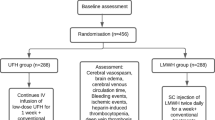Abstract
Background
Thromboembolic events represent a clinically significant cause of neurological morbidity during the endovascular management of cerebral aneurysms. We have implemented an anti-thromboembolic regimen consisting of pre- and postoperative dual antiplatelet therapy, as well as postoperative anticoagulation using heparin and dextran. The aims of our study were to examine the effect of this regimen on thromboembolic rates during elective aneurysm coiling, and to elucidate risk factors associated with the development of thromboembolic events in this setting.
Methods
We conducted a retrospective review of patients who underwent elective intracranial aneurysm coiling between January 2005 and February 2012. The primary outcome of interest was the occurrence of a clinically significant peri-procedural thromboembolic event. Secondary outcomes included the occurrence of a central nervous system (CNS) or systemic hemorrhage.
Results
During the study period, 312 patients underwent elective aneurysm coiling and six (2 %) thromboembolic events occurred; three (1 %) occurred in the group that received the anti-thromboembolic regimen (261 patients) and three (6 %) occurred in the group that did not receive the regimen (51 patients), resulting in a statistically significant difference (P = 0.024). Both the presence of a hypercoagulable state (P = 0.014) and the lack of the anti-thromboembolic regimen (P = 0.043) were significantly associated with the occurrence of a thromboembolic event.
Conclusions
This study provides evidence that the regimen described here is safe and reduces thromboembolic complications during elective aneurysm coiling. Ours is likely the most aggressive regimen in the published literature and significantly reduced the rate of thromboembolism without any significant increase hemorrhagic complications.
Similar content being viewed by others
References
Akbari SH, Reynolds MR, Kadkhodayan Y, Cross DT 3rd, Moran CJ (2012) Hemorrhagic complications after prasugrel (Effient) therapy for vascular neurointerventional procedures. J Neurointerv Surg 5:337–343
Brooks NP, Turk AS, Niemann DB, Aagaard-Kienitz B, Pulfer K, Cook T (2008) Frequency of thromboembolic events associated with endovascular aneurysm treatment: retrospective case series. J Neurosurg 108:1095–1100
Grunwald IQ, Papanagiotou P, Politi M, Struffert T, Roth C, Reith W (2006) Endovascular treatment of unruptured intracranial aneurysms: occurrence of thromboembolic events. Neurosurgery 58:612–618, discussion 612-618
Hayes PD, Lloyd AJ, Lennard N, Wolstenholme JL, London NJ, Bell PR, Naylor AR (2000) Transcranial Doppler-directed Dextran-40 therapy is a cost-effective method of preventing carotid thrombosis after carotid endarterectomy. Eur J Vasc Endovasc Surg 19:56–61
Hovens MM, Snoep JD, Eikenboom JC, van der Bom JG, Mertens BJ, Huisman MV (2007) Prevalence of persistent platelet reactivity despite use of aspirin: a systematic review. Am Heart J 153:175–181
Hwang G, Jung C, Park SQ, Kang HS, Lee SH, Oh CW, Chung YS, Han MH, Kwon OK (2010) Thromboembolic complications of elective coil embolization of unruptured aneurysms: the effect of oral antiplatelet preparation on periprocedural thromboembolic complication. Neurosurgery 67:743–748, discussion 748
Jones CI, Payne DA, Hayes PD, Naylor AR, Bell PR, Thompson MM, Goodall AH (2008) The antithrombotic effect of dextran-40 in man is due to enhanced fibrinolysis in vivo. J Vasc Surg 48:715–722
Lau WC, Gurbel PA, Watkins PB, Neer CJ, Hopp AS, Carville DG, Guyer KE, Tait AR, Bates ER (2004) Contribution of hepatic cytochrome P450 3A4 metabolic activity to the phenomenon of clopidogrel resistance. Circulation 109:166–171
Matsumoto Y, Kondo R, Matsumori Y, Shimizu H, Takahashi A, Tominaga T (2012) Antiplatelet therapy for prevention of thromboembolic complications associated with coil embolization of unruptured cerebral aneurysms. Drugs R D 12:1–7
Naylor AR, Hayes PD, Allroggen H, Lennard N, Gaunt ME, Thompson MM, London NJ, Bell PR (2000) Reducing the risk of carotid surgery: a 7-year audit of the role of monitoring and quality control assessment. J Vasc Surg 32:750–759
Oxley TJ, Dowling RJ, Mitchell PJ, Davis S, Yan B (2011) Antiplatelet resistance and thromboembolic complications in neurointerventional procedures. Front Neurol 2:83
Parri MS, Gianetti J, Dushpanova A, Della Pina F, Saracini C, Marcucci R, Giusti B, Berti S (2012) Pantoprazole significantly interferes with antiplatelet effect of clopidogrel: Results of a pilot randomized trial. Int J Cardiol 1:2177–2181
Prabhakaran S, Wells KR, Lee VH, Flaherty CA, Lopes DK (2008) Prevalence and risk factors for aspirin and clopidogrel resistance in cerebrovascular stenting. AJNR Am J Neuroradiol 29:281–285
Reavey-Cantwell JF, Fox WC, Reichwage BD, Fautheree GL, Velat GJ, Whiting JH, Chi YY, Hoh BL (2009) Factors associated with aspirin resistance in patients premedicated with aspirin and clopidogrel for endovascular neurosurgery. Neurosurgery 64:890–895, discussion 895-896
Schubert GA, Thome C, Seiz M, Douville C, Eskridge J (2011) Microembolic signal monitoring after coiling of unruptured cerebral aneurysms: an observational analysis of 123 cases. AJNR Am J Neuroradiol 32:1386–1391
Soeda A, Sakai N, Sakai H, Iihara K, Yamada N, Imakita S, Nagata I (2003) Thromboembolic events associated with Guglielmi detachable coil embolization of asymptomatic cerebral aneurysms: evaluation of 66 consecutive cases with use of diffusion-weighted MR imaging. AJNR Am J Neuroradiol 24:127–132
Stetler WR, Chaudhary N, Thompson BG, Gemmete JJ, Maher CO, Pandey AS (2012) Prasugrel is effective and safe for neurointerventional procedures. J Neurointerv Surg 5:332–336
Yamada NK, Cross DT 3rd, Pilgram TK, Moran CJ, Derdeyn CP, Dacey RG Jr (2007) Effect of antiplatelet therapy on thromboembolic complications of elective coil embolization of cerebral aneurysms. AJNR Am J Neuroradiol 28:1778–1782
Disclosures
The authors have no financial disclosures or conflicts of interest.
Author information
Authors and Affiliations
Corresponding author
Rights and permissions
About this article
Cite this article
Wilson, T.J., Pandey, A.S., Stetler, W.R. et al. Dual antiplatelet therapy plus postoperative heparin and dextran is safe and effective for reducing risk of embolic stroke during aneurysm coiling. Acta Neurochir 156, 855–859 (2014). https://doi.org/10.1007/s00701-014-2031-y
Received:
Accepted:
Published:
Issue Date:
DOI: https://doi.org/10.1007/s00701-014-2031-y




